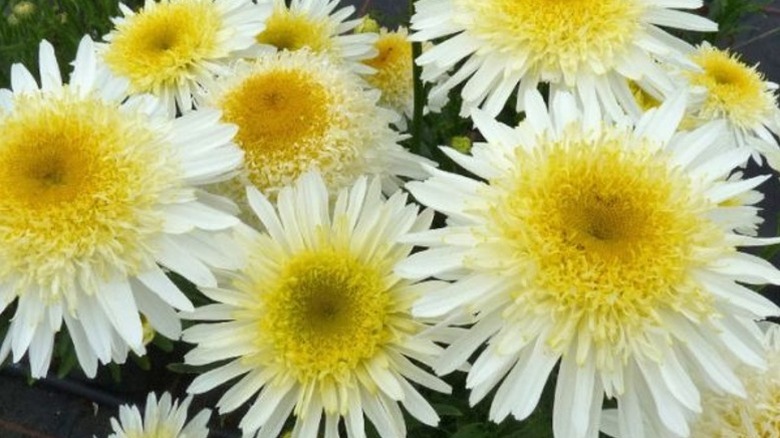The Hardy Perennial To Plant In Fall For A Summer Full Of Stunning Yellow Blooms
Right before winter rolls around, fall gives us a short and precious window of opportunity to get our hands dirty and plant some things in the garden. Hardy perennials, when planted in the fall, die down with winter's cool temperatures, only to come back vibrant and blooming in the spring and summer. If you're looking to give yourself a small and colorful gift, consider planting some 'Real Glory' leucanthemums (Leucanthemum x superbum), also known as Shasta daisies. These should be planted in the fall, not much later than October, so don't let this opportunity slip away.
These gorgeous white and yellow flowers are perennial in the USDA hardiness zones 5 through 9. This means that in most of the United States, except for the northernmost states like North Dakota or Montana, you should be able to plant them in the fall, and they'll come back in full force next blooming season. Many perennials will never leave your garden once planted, so expect endless blooms every spring and summer. These are a very tough variety of daisies that can survive in the ground even as temperatures drop to -20 degrees Fahrenheit, which is pretty impressive. 'Real Glory' Leucanthemums will bloom right through the summer, and into the fall, after which they die down for the winter season.
The 'Real Glory' variety of Leucanthemums is stunning because of its unique form. These flowers have the typical white petals and yellow core of a daisy, but with much fuzzier and denser petals. They have small, pale yellow petals that surround the yellow center of the flower, which creates a gradient effect and blends in beautifully with the larger white petals.
How to plant 'Real Glory' leucanthemums
To grow your own 'Real Glory leucanthemums, purchase a few plants from a local nursery. You need to plant these as flowers, not as seeds, so buy them in small nursery pots. These stunning flowers like full sun, so you need to find a spot in your garden that isn't shaded. They also prefer well-draining soil that doesn't easily get waterlogged. If your garden soil isn't ideal for this, you can improve heavy clay soils by adding organic matter, or you can use an easy DIY soil mix if planting in garden containers.
Once you've identified the right place for your daisies, get digging. You'll need a hole that's slightly deeper than the daisies' roots (use the nursery pot as a reference), and about twice as wide. Remove the plants from their pot and, with your fingers, gently loosen the roots. Place each plant in its hole, and backfill it with soil mix or the soil you dug out earlier. Use your hand to firm the soil and water well. Continue to water often to help the roots establish themselves, but avoid drowning the plant with too much liquid. Next growing season, when the plant is fully established, it will require less water since Leucanthemums are drought-tolerant.

